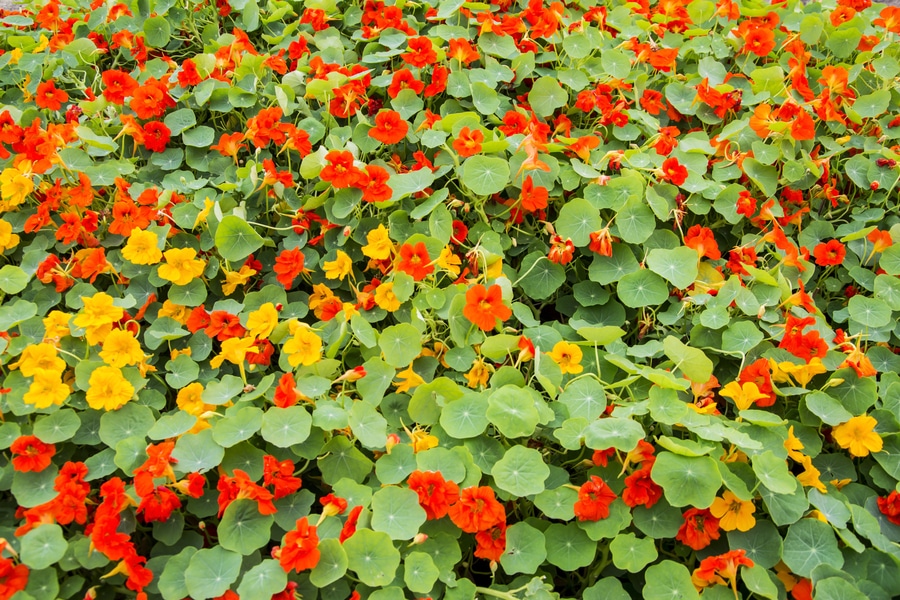Garden Nasturtium: A Guide On How To Grow & Care For Nasturtiums

Read on how to grow nasturtium in your garden and enjoy its beauty and benefits.
What Are Nasturtium Plants?
Wide varieties are available, including trailing, climbing, and dwarf varieties, and their flowers come in beautiful warm shades, such as yellow, red, orange, and white. The deep green, rounded leaves have light-coloured radiating veins. And the leaves and stems are fleshy.
Planting nasturtiums is an excellent trap crop in companion planting, diverting aphids and other garden pests away from your vegetables and roses. The herbaceous plant is in-demand, particularly as an accessory decoration for flower beds and borders and as a spiller in window boxes and hanging baskets.
Aside from dressing up your vegetable garden, nasturtium is an edible plant. Its edible flowers and leaves contain a high amount of vitamin C and a distinct spicy, peppery taste. The seeds are sometimes called “poor man’s capers” and can be used as capers in the culinary world.
Nasturtium Varieties
Alaska
Orange Gleam
Canary creeper
Peach Melba
Empress of India

How To Plant Nasturtiums In Your Garden
When To Plant Nasturtium
Growing Nasturtium Seeds
For the planting site, nasturtium does best in poor soil and need sunlight for at least half the day. Trailing types can be trained along trellises, cascade on retaining walls, in hanging baskets/containers, or fill in a border. In contrast, plant dwarf varieties where space is limited or in pots.
Start The Seeds Indoors
Nasturtium seeds are coated with a hard layer. To help germinate, nick the outer coating and soak them for up to 12 hours in lukewarm water. After soaking, dry them on a paper towel. Sow one seed per biodegradable pot at a depth of half an inch. Use seed substrate and not potting soil.
Keep the pots near your sunniest window, and keep the peat moist. If you live in a place with cloudy winters, you must have a grow light. Seedlings must appear within 7 to 10 days after planting. Afterwards, you can transplant the seedlings outdoors without disturbing their roots when they grow nearly 5 to 6 inches taller.
Transplant them in your garden after hardening and after the last frost of the season. Nasturtium seedlings are sensitive to transplanting, so make sure you harden them off before transferring them outdoors.

Sow Directly In Garden Beds
For outdoor planting, direct sow seeds beginning one week after the last frost. Soil temperatures must preferably be between 55°F and 65°F. Choose a location that’s shaded from the midday summer heat.
Soil preparation mainly involves removing all weeds and raking the soil to a fine tilth. Water the area before you sow seeds.
Plant nasturtium seeds 1/2 inch deep and about 10 to inches apart for small varieties or up to 24 inches for large ones. Place two or three seeds in each planting hole. Keep them hydrated until the seeds sprout in 7-10 days.
In some cases, direct sowing is risky since you might root up the seedlings when weeding the bed. Avoid accidental weeding by labelling the planting site. Due to the typical abundant foliage, nasturtium seedlings are easily recognizable.
Sowing Nasturtiums In Pots
Nasturtiums grow best in natural stone or clay containers with good drainage. Combine the compost with fine gravel or grit to increase the drainage capacity and lower nutrient levels since they prefer poor soil.
Sow one or two nasturtium seeds per pot to avoid outgrowing. Leave about an inch of space between the compost level and the lip of the pot.
How To Care For Nasturtiums
Light
Soil
Water
Fertilizer & Mulch
Applying mulch around your Nasturtium plants can be a wonderful way to encourage healthy growth. Mulch made of aged compost will keep your soil moist and cool, inducing livelier flower blooms. In more temperate climates, mulch is usually not required.
Pruning
Snip the longest stems by 6 to 12 inches on trailing varieties and lessen browning leaves and flowers by pinching them off at the base. Shortening stems is not generally required for bushy varieties, but shearing spent flowers and dried leaves will improve the plant’s natural beauty.
If you’re growing nasturtiums in pots, they must be cut back periodically throughout the growing season. This encourages them to produce more of their desirable leaves.
Suppose plants get wood or lanky, trim plants by a third of their length. When cool nighttime temperature comes, they’ll quickly produce new growth.
Weeding

How To Propagate Nasturtiums
With sterilized gardening scissors, cut off a section of plant 3-5 inches long from the main plant, just below a leaf. It’s better to snip them instead of pulling them off. You likewise have to apply some rooting hormones. Remove the cutting’s bottom half set of leaves for roots to grow.
Fill the pot with potting soil or propagating medium. Place a coffee filter in the bottom of a container to prevent the soil from flowing out.
Place the cutting in the rooting compound up to the leaf node. Backfill the hole gently with your fingers and water the pot carefully.
Set the pot in a protected area with morning sunlight and evening shade. Make sure you are keeping the medium hydrated the whole time.
In two to three weeks, the cutting will grow new leaves, suggesting that roots are growing into the soil.
Once firmly rooted, transplant the stem into your sunny garden with the entire pot. Or then, you can transplant it into a container filled with a standard potting mix.
How To Harvest & Collect Seeds And Flowers
The plant is ready to be collected when it’s roughly 6 inches tall. When it comes to flowers, they are best harvested as soon as they bloom. Hence, think of how many you can reap in one stretch. You can simply pick some leaves, or buds, every once in a while to toss in a salad or use as a culinary decoration.
Use a pair of scissors to take what you need. Try to snip off only a little from one plant – only harvest 30% of leaves for continuous growth. Remember that these plants carry a pungent, peppery flavour, so you only want a little to spice your food.
Pick flowers, leaves and green seed pods in the morning before the sun’s heat has warmed them. This is when the blooms are their most plump.
Also note: you must leave your harvest for a few minutes after clipping. In this way, any ‘inhabitants’ can escape, and you will only end up biting what you can chew!
Common Pests & Diseases

Pests
You can also curb them with a strong spray of water from a garden hose, which is often enough to eliminate them. Or try wiping down the leaves with soapy water to deter pests. Never apply insecticides if you will use nasturtium in cooking.
Most gardeners grow nasturtiums on the edges of their vegetable gardens to keep pests at bay. Gardeners who use this approach must inspect the plant for bugs once a week and pull them off as needed.
Another brilliant method is to sprinkle diatomaceous earth around the base of plants to hold off snails, slugs and squash bugs.
Diseases
Powdery Mildew
Bacterial Leaf Spot
Maintain the cleanliness of the area in your garden and remove any botanical debris before it can generate disease. Any equipment or tools that come in contact with infected plants must be disinfected.
Companion Plants When Growing Nasturtiums
Planting nasturtiums with fruiting plants can help prevent aphids, squash bugs, and other pests that would otherwise feast on your other crops by masking the aromas of leaves and emerging fruits. Their strong, peppery oils help in disguising sweeter smells.
At the same time, they lure beneficial insects like pollinators and hoverflies. They can control garden pests, creating a natural pest trap and healthy biome in your garden. Once the pollinators are drawn to your garden, they will be more adapted to pollinate your other plants.
The plant’s heavy spread also makes it an excellent ground cover, screening the soil to reduce moisture loss. Using them as “filler” in your garden beds, you utilize available space so undesirable weeds can’t infiltrate.
Plant nasturtium with these plants to keep them healthy, fruitful, and pest-free:
- broccoli
- cabbages
- cauliflower
- cucumbers
- kale
- melon
- potatoes
- pumpkins
- radishes
- rose
- tomatoes
- zucchini

Conclusion
Colin Macmillan is a seasoned entrepreneur and the CEO of Riverwood Landscape, a leading landscaping company based in Canada. He has been at the helm of the company since leaving high school, demonstrating his strong leadership skills and business acumen.
Colin’s expertise lies in various aspects of landscaping, including lawn care, interlocking, sod installation, and commercial maintenance. His hands-on approach and dedication to the craft have been instrumental in building Riverwood Landscape into a reputable brand.
One of his most notable achievements is the creation of a successful landscape franchise that services multiple locations. This accomplishment underscores his strategic thinking and ability to scale operations effectively.
Colin has also had the privilege of working with Guelph Hospital for landscaping and maintenance, a testament to the trust and reliability that his company has earned over the years.
His professional mission is to offer the best services and experiences for customers, a goal that he tirelessly pursues. Colin’s commitment to excellence and customer satisfaction continues to drive the growth and success of Riverwood Landscape.








